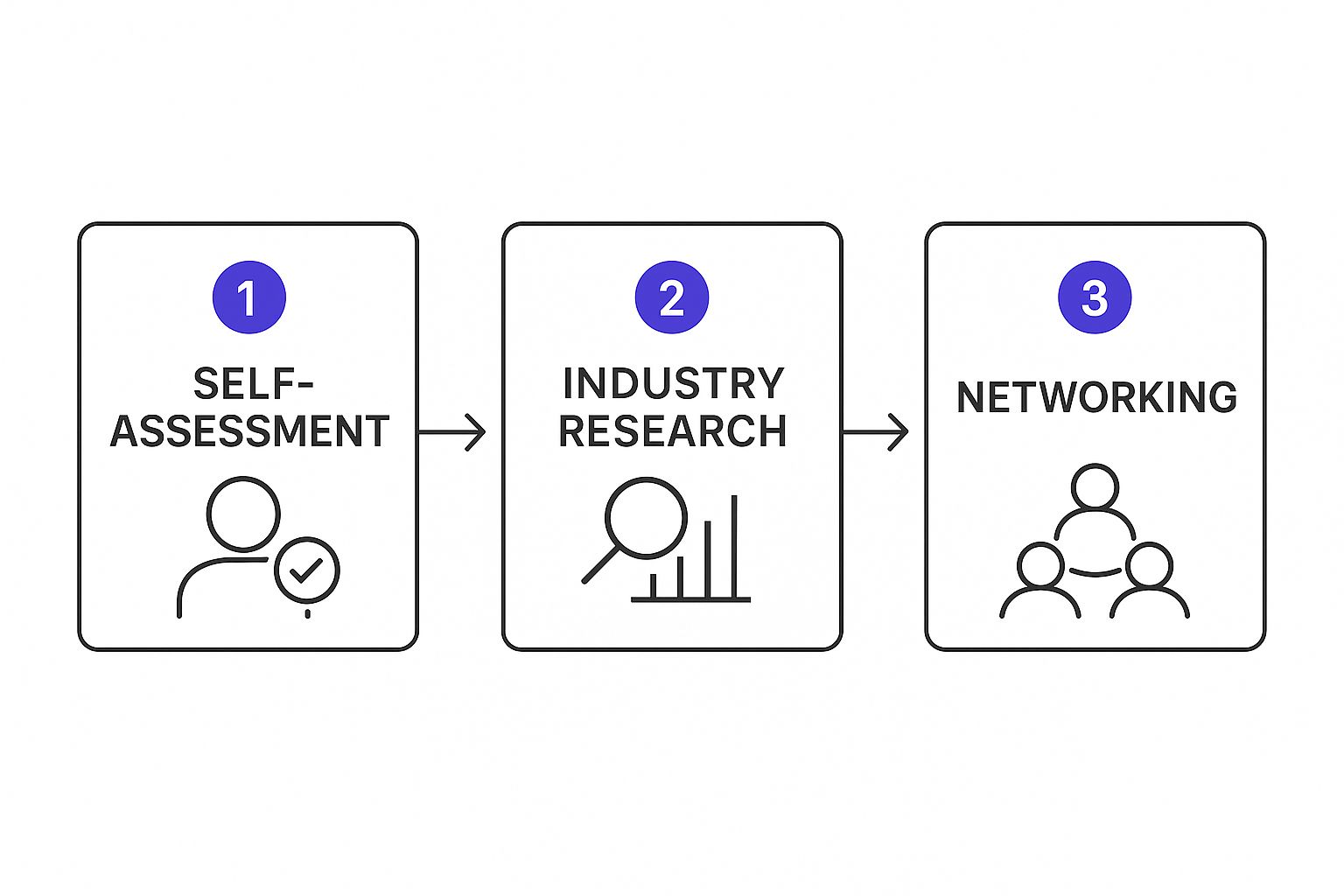How to Pivot Careers and Find Your Dream Job
Switching careers isn't just about finding a new job. It's about a full-on strategic reinvention of your professional self. I've seen it time and time again—the people who succeed are the ones who start with a deep look inward, then do their homework on new industries, and finally, build the right connections to make the jump.
Welcome to the New Reality of Career Pivoting
Let's be honest, the idea of a linear career path is dead. The "start with one company and retire 40 years later" model feels like a story our grandparents would tell. Today's professional journey is much more of a winding road, full of strategic twists and intentional turns.
Making a big career change used to carry a stigma, like you couldn't make up your mind. Not anymore. Now, it’s seen as a sign of adaptability and a smart, proactive way to grow.
This isn't just a feeling; it's a reality shaped by massive external forces. Technology, especially AI, is completely reshaping entire industries. If you want a real wake-up call, just look into the impact of AI on job markets. This constant churn means we all have to be ready to learn and evolve.
It’s not just about technology, though. There's also a huge cultural shift happening. More and more, people are looking for work that offers more than a paycheck. They want purpose. They want their work to mean something and align with their values. This has made the career pivot an essential move for finding genuine, long-term career satisfaction.
A successful pivot is never a random leap of faith. It's a calculated move built on self-awareness, solid research, and a clear strategy to connect your past with your future.
Your Roadmap for Reinvention
Thinking about a total career change can feel massive, almost paralyzing. But it becomes a lot less scary when you break it down into a clear, manageable process. It’s less about one giant leap and more about a series of deliberate, well-planned steps. Think of it as building a bridge to your next chapter, one plank at a time.
This flow shows the core stages of any successful pivot, moving from that internal discovery phase to concrete, external action.

Each of these stages builds directly on the last. This ensures you're making informed decisions instead of just guessing and hoping for the best.
The numbers back this up, too. The World Economic Forum's Future of Jobs Report found that a staggering 44% of workers will need to update their core skills in the next few years just to stay competitive. The report also shows that while automation might displace some roles, it’s set to create even more new ones in fields like tech, green energy, and healthcare.
The message is loud and clear: standing still is the riskiest move you can make. The modern professional has to be a lifelong learner, always ready to adapt.
To help you get started, I've put together a quick reference table. Think of this as your high-level map for the journey ahead.
Quick Guide to a Successful Career Pivot
| Phase | Primary Goal | Key Actions |
|---|---|---|
| 1. Self-Assessment | Find your "why" and identify your core strengths. | Define your values, financial needs, and transferable skills. |
| 2. Exploration | Discover viable new career paths. | Research growth industries, analyze job roles, conduct informational interviews. |
| 3. Skill-Building | Bridge the gap between your current skills and future needs. | Take courses, earn certifications, find freelance projects for hands-on experience. |
| 4. Execution | Land a job in your new field. | Rewrite your resume, network strategically, and perfect your career-change story for interviews. |
With a clear framework like this, you can turn what feels like a daunting challenge into an exciting, empowering opportunity for reinvention.
Conducting Your Personal Pivot Audit

Before you even glance at a job board or think about a new industry, the real work begins. And it starts with you. A career pivot that sticks isn't about running away from a job you hate; it's about running toward a future that actually fits. To do that, you need to get brutally honest with yourself.
Think of it as a personal audit. You're the consultant, and your career is the client. The first step is gathering data—not just about what you can do, but about what makes you tick, what you stand for, and what you absolutely refuse to compromise on. This groundwork is what stops you from just leaping from one bad-fit role to another.
Find What Genuinely Fires You Up
Forget job titles for a minute. Think about the specific moments at work when you felt completely in the zone. When did time fly by? Maybe you were untangling a messy spreadsheet, mentoring a new teammate, or presenting a creative idea that got everyone excited.
These aren't just good days; they're your "energy peaks." They are powerful clues that point directly to the kind of work that truly fuels you. Grab a notebook and jot them down without overthinking it. The goal here is to spot a pattern. What activities consistently give you a boost, and which ones leave you feeling completely drained?
Pinpoint Your Core Values and Non-Negotiables
Your values are your internal compass, and if your job constantly points you in the opposite direction, you're heading straight for burnout. It doesn't matter how good the paycheck is.
So, what truly matters to you in a professional setting? Is it having the freedom to work your own way, or do you thrive on team collaboration? Is it stability, or the chance to build something new from scratch?
Common Career Values to Consider:
- Autonomy: The freedom to own your work and manage your schedule.
- Collaboration: Working in a tight-knit team to hit shared goals.
- Creativity: The space to innovate and bring new ideas to the table.
- Stability: A predictable role with solid job security.
- Leadership: The opportunity to guide, mentor, and inspire others.
- Work-Life Balance: A hard line between your professional and personal life.
Take a moment to pick your top three to five. These are your non-negotiables. They become the filter through which you'll evaluate every single opportunity that comes your way.
A pivot without understanding your core values is just a shot in the dark. Knowing your non-negotiables turns your job search from a random wander into a targeted mission.
Do a Financial Reality Check
Let's talk about the elephant in the room: money. Worrying about finances is one of the biggest stressors in any career change. Before you make a single move, you need to get a clear-eyed view of your financial runway—how long can you realistically support yourself without a steady paycheck?
This isn’t meant to scare you; it's about making a smart plan. Add up your essential monthly bills (rent, food, utilities, loan payments) and compare that to your savings. Knowing this number dictates your strategy. A short runway might mean you need to upskill on nights and weekends while staying in your current job. A longer runway could open the door to a full-time coding bootcamp or a certificate program.
Take Stock of Your Transferable Skills
Every job you've ever had has given you skills that are valuable in other industries. These are your transferable skills, and they are the bridge between your past experience and your future goals. Honestly, most people I talk to dramatically underestimate how much they have to offer here.
Think beyond your job description and focus on your accomplishments. Did you manage a project from start to finish? Did you persuade a tough client to see your point of view? Did you find a way to make a clunky process more efficient? Those are all highly valuable skills.
Key Transferable Skills Employers Always Look For:
- Communication: Clearly presenting ideas, writing emails that get results, and truly listening.
- Problem-Solving: Spotting issues, analyzing the options, and making things work.
- Project Management: Juggling tasks, hitting deadlines, and steering a project across the finish line.
- Leadership: Mentoring junior staff, running team meetings, or just taking the lead on something new.
As you start listing these out, it’s a good idea to keep them organized. While a simple document is fine, using a dedicated tracker from day one can save you a lot of headaches later on. In fact, the principles in our guide to creating a job application tracking spreadsheet can be easily adapted to inventory your skills and map them to potential roles.
Once you’ve gone through this audit, you'll have a clear direction. You’ll have a map of your passions, a set of non-negotiable values, a realistic financial plan, and a powerful list of skills you can take anywhere. Now you’re ready to start exploring.
Mapping Your Next Career Move

Okay, you’ve done the hard work of looking inward. With your personal audit complete, you're not just guessing anymore. You’ve got a real handle on your strengths, what you value, and your financial runway.
Now it's time to shift gears. We’re moving from internal reflection to external exploration. The goal is to turn that vague feeling of "I need something new" into a concrete shortlist of career paths that actually make sense for you. Think of yourself as a detective, hunting for industries and roles that line up with the personal blueprint you just created.
Identify High-Growth Sectors
Let’s be strategic. The smartest way to pivot is to head toward opportunity. Focusing on high-growth sectors gives you a massive advantage. These industries are hungry for new talent and are often far more open to hiring people with diverse backgrounds and transferable skills. It’s about working with the current, not against it.
A quick look at labor market trends tells a powerful story. For instance, recent projections for 2023 to 2033 show the healthcare and social assistance sector is set to add a staggering 2.3 million jobs.
Renewable energy is another hot spot, with solar and wind power jobs projected to surge by 275.9% and 115.1%, respectively. And it’s no surprise that computer and IT roles continue to grow much faster than the average. This data isn't just numbers on a page; it's a map pointing you toward promising destinations where your pivot has the best chance of success.
Decode Job Descriptions to Find Your Fit
Once you have a few promising industries on your radar, it's time to get granular. Dig into specific job descriptions. This is a critical step that so many people either rush through or skip entirely, but it's where you find the real gold. A job description is more than a list of qualifications; it's a window into the day-to-day reality of a role.
How to really analyze a job description:
- Look for Your Keywords: Do the responsibilities and tasks listed sound like the "energy peaks" you identified in your self-assessment?
- Translate the Jargon: Every industry has its own language. Start learning it. Figure out what "stakeholder management" or "agile methodology" actually means in practice for that role.
- Find the Real Skills: Look past the jargon. A requirement for "experience with CRM software" isn't just about knowing a specific program. It's about customer relationship management, data organization, and process thinking.
By carefully dissecting these descriptions, you’ll start to see exactly how your existing skills build a bridge to this new field. More importantly, you'll get a clear picture of any skill gaps you might need to fill.
Don't get discouraged if you don't check every single box. Most job descriptions are a "wish list," not a hard-and-fast checklist. If you match 70-80% of the requirements and can show you're eager to learn, you're often a solid candidate.
Get the Inside Scoop with Informational Interviews
Reading about a career online is one thing. Hearing about it directly from someone who lives and breathes it every day? That's a whole different level of insight. Informational interviews are your secret weapon for getting an unfiltered, real-world perspective on a potential new career.
These aren't job interviews. They are low-pressure chats where you ask the questions. The goal is simple: gather intelligence, not ask for a job. I’ve found that most people are surprisingly happy to talk about their work, and these conversations can give you information you’d never find in an article or on a company website.
So, where do you find these people? Start with your existing network, scroll through LinkedIn, or check out professional associations in your target industry. A simple, polite message explaining you're exploring a career change and admire their career path is often all it takes to start a conversation. For more on this, our guide on strategic networking for your job search offers some great tips for making these connections.
By the end of this mapping process, you should have a solid shortlist of two to three specific, well-researched career paths that genuinely excite you. This clarity is the foundation for everything that comes next.
Building Your Bridge to a New Career

Alright, you’ve done the soul-searching and mapped out a few exciting new career paths. Now for the fun part: actually building the bridge to get you there. This is where the rubber meets the road—where you strategically close the gaps between the pro you are today and the pro you need to be for that new role.
Knowing how to pivot careers isn't just about learning new things; it’s about learning the right things. Forget collecting random certificates. We're talking about a focused, efficient plan to gain the exact skills that make hiring managers sit up and take notice.
Design Your Personalized Learning Plan
Every career change is different, so a cookie-cutter approach to upskilling is a waste of time. Your first move is to get surgical.
Revisit those job descriptions you saved and pull out all the most frequently mentioned skills, both hard and soft. This list is your personal curriculum. Once you have it, you can pick the best way to learn based on your budget, timeline, and how you learn best.
- Formal Certifications: These are gold in fields where a specific credential carries serious weight. Think project management (PMP) or cloud computing (AWS Certified Cloud Practitioner).
- Online Courses: Platforms like Coursera, edX, and Udemy are amazing for their flexibility and sheer variety. You can find anything from digital marketing basics to advanced Python programming.
- Intensive Bootcamps: If you're looking to make a fast, deep dive into a tech-focused role like UX/UI, data analytics, or software development, a bootcamp is a solid bet. They're a big investment, but they offer structured, project-based learning that gets you job-ready quickly.
The real magic happens when you mix and match. You might take a deep online course to get the foundational knowledge, then earn a specific certification to prove it to employers.
The goal isn't just to learn; it's to acquire skills you can immediately show. Prioritize learning paths that include hands-on projects—these will become the first crucial pieces of your new professional portfolio.
Gain Experience Without the Job Title
Ah, the classic career-changer's paradox: "How do I get experience when no one will hire me without it?"
Simple. You create your own. You don't need a formal title to start building real-world credibility. Being proactive here is what separates a pivot that soars from one that stalls. This is your chance to show, not just tell.
Actionable Ways to Build Hands-On Experience:
- Freelance and Gig Work: Hop on platforms like Upwork or Fiverr and take on small, paid projects. A future graphic designer can create logos for local businesses. An aspiring writer can start a blog or take on content gigs.
- Volunteer for a Cause: Non-profits are almost always looking for skilled help. Offer to run their social media, redesign their website, or analyze donor data. It’s fantastic experience and gives you a powerful story to tell in interviews.
- Create Personal Projects: This is where your passion can really shine. Build a simple app, launch a podcast, conduct your own market research, or design and code your personal website from scratch. Nothing screams initiative like a self-driven project.
Every project you complete is another point of proof. It's tangible evidence that you can do the work. As you build this bridge, make sure your online presence reflects it. Documenting your projects using effective LinkedIn post writing tips helps you build a public narrative around your transition.
By combining targeted learning with these hands-on projects, you’re building an undeniable case for why a company should take a chance on you. You're no longer just a "career changer"—you're an emerging professional with proven skills and a clear passion for the field.
Executing a Winning Pivot Strategy
All that soul-searching and late-night research has brought you to this point. You’ve identified your new dream role and spent time building a bridge of new skills to get there. Now, it's time to actually walk across it.
Making a successful career pivot isn't about blasting out hundreds of generic applications. It’s about telling a masterful story. This is where your hard work meets opportunity, and it all comes down to translating your journey into a strategy that convinces a hiring manager to bet on your potential, not just your past.
Rewrite Your Professional Story
Let's be blunt: your old resume is useless for your new career. It’s written in the wrong language and highlights achievements for a job you don't even want anymore. When you're making a major shift, your resume and LinkedIn profile have to stop being historical documents and start being forward-looking marketing tools.
Instead of just listing your old duties, you need to reframe your entire professional narrative. Start with a powerful summary that immediately explains the change. Lead with your new goal and highlight the top 3-4 skills—whether they're transferable or brand new—that make you a perfect fit for this new industry.
Resume Reframing Example:
- Old Title: Senior Account Manager, Advertising
- New Summary: "Aspiring Product Marketing Manager with a foundation in client strategy and a recent certification in Digital Marketing Analytics. Ready to apply 7+ years of experience in go-to-market planning and cross-functional communication to drive product adoption in the SaaS space."
See the difference? This approach immediately makes your advertising background sound like highly relevant experience for product marketing. Every bullet point that follows needs to echo this new story, quantifying your past achievements in a way that aligns with your new target role.
Network with Purpose, Not Panic
Networking during a career change can feel incredibly daunting. I get it. The trick is to shift your mindset from, "I desperately need a job," to, "I'm genuinely curious and want to learn." People are always more willing to help someone who is authentic and eager to learn, not someone who feels transactional.
Your goal is to build real relationships with people who are already where you want to be. Start by letting your existing network know about your new direction—you'd be surprised who knows who. Then, fire up LinkedIn and find professionals at companies that excite you.
Send a short, personalized connection request. The key is to ask for insight, not a job.
"Hi [Name], I'm currently pivoting from [Your Old Field] to [Your New Field] and I'm so impressed by the work you're doing at [Their Company]. If you have 15 minutes in the coming weeks, I'd love to hear about your experience in the industry."
These informational interviews are gold. A single warm introduction from a new contact is often far more powerful than a hundred cold applications sent into the void.
Ace the Pivot-Specific Interview Questions
When you land that interview, you know the big question is coming: "So, why the career change?" A shaky, vague, or defensive answer can be an instant deal-breaker. You need a story that’s concise, confident, and positive.
A Simple, Three-Part Structure for Your Pivot Story:
- The Origin: Briefly touch on what you enjoyed and accomplished in your previous career, focusing on the core skills you built (like project management or data analysis).
- The Turning Point: Describe what sparked your interest in this new field. Always frame it as a pull toward something exciting, not a push away from something you hated.
- The Future Vision: Connect the dots. Explain exactly why you're a strong fit for this role at this company, and how your unique background gives you a fresh perspective they need.
Your enthusiasm is a huge asset here. Show them you’ve done the research and are genuinely excited about the work they do. Proactively addressing your pivot demonstrates self-awareness and strategic thinking—two qualities every employer is looking for.
Your cover letter is the perfect place to set the stage for this conversation, explicitly explaining the "why" behind your transition. It bridges the gap on paper, making a hiring manager eager to hear more. To make sure you’re moving through this process as efficiently as possible, check out these strategies on how to get hired faster. You've done the hard work of reinventing yourself; now it's time to go show the world.
Your Top Career Pivot Questions, Answered
Making a major career change is a huge deal, and it's totally normal to have a head full of questions. That mix of excitement and "what if?" is part of the process. To help you get some clarity, I've rounded up the most common questions people have when they're figuring out how to pivot.
Think of this as your go-to guide for the final stretch of your transition. Getting these answers locked in will give you the confidence you need to take that next big step.
How Do I Explain My Career Change in an Interview?
This is the question that keeps so many career changers up at night. But honestly? It's your best chance to tell your story and show them why you're a unique find. The key is to avoid sounding defensive. You want to frame this as a deliberate, strategic move—not an escape plan.
You need to craft a compelling narrative that connects the dots for the hiring manager. Start by pointing out the valuable, transferable skills you honed in your last career. Then, walk them through how your growing passion for this new field led you to intentionally seek out the specific skills you needed to succeed here. The goal is to show them this wasn't just a random leap of faith, but a calculated move toward a career where you can make a much bigger impact.
Don't frame your past career as something you're running away from. Instead, present it as the solid foundation you've built upon. Your pivot is a story of ambition and growth, demonstrating how your unique background makes you the perfect person to solve their problems in a fresh, new way.
When you're getting your answer ready, make sure you practice saying it out loud. You can find some fantastic tips and questions for job interview practice to help you polish your story until it feels confident and completely natural.
Is It Better to Get a Certification or a Degree?
Ah, the great "certification vs. degree" debate. The truth is, there's no single right answer—it all comes down to the industry you're trying to break into. Your best move here is to do some digging into your target field.
For a lot of tech-heavy roles—think data science, cybersecurity, or digital marketing—a respected certification or a certificate from an intensive bootcamp is often all you need. These credentials are solid proof that you have the specific, hands-on skills employers are looking for right now.
On the other hand, for fields like healthcare, law, or counseling, a formal degree and a state-recognized license are usually non-negotiable. They're often legal and professional requirements. The easiest way to know for sure? Go back to those job descriptions you saved. They'll tell you exactly what qualifications are expected.
How Long Should a Career Pivot Take?
Everyone’s timeline is different, but it really helps to have a realistic one in your head. Trying to rush it is a surefire way to end up in another role that isn't the right fit. Generally speaking, a well-planned career pivot takes somewhere between 6 to 18 months.
Let's break that down:
- Self-Assessment & Reflection: This initial phase of figuring out your "why" usually takes about 1-2 months.
- Research & Exploration: Actually mapping out potential roles and industries can take another 2-4 months.
- Skill-Building & Upskilling: This is the most flexible part of the timeline, ranging anywhere from 3-12 months depending on what you need to learn.
- Active Job Search: The final push of networking, applying, and interviewing typically lasts 2-6 months.
The two biggest things that will stretch or shrink that timeline are your financial runway and the size of your skills gap. Planning for this timeframe from the start helps keep expectations in check and reduces a ton of stress.
What Is the Biggest Pivot Mistake to Avoid?
If there's one mistake I see people make over and over again, it's this: they skip the foundational work. They get so excited about a trendy job title or the promise of a bigger paycheck that they jump straight into applying for jobs or signing up for a bootcamp without a clear sense of direction. They haven't done the personal audit.
What happens next is predictable. They end up dissatisfied and ready for another pivot just a few years down the road. Taking the time to truly understand your own values, interests, and non-negotiables isn't a skippable step. It is, without a doubt, the most critical part of making sure your next career is one that lasts and actually makes you happy.
Feeling like you're juggling too many moving parts in your job search? Stay organized and focused on what really counts. Eztrackr lets you manage all your applications, create AI-powered cover letters, and track your progress in one simple dashboard. It’s time to stop wrestling with spreadsheets and start landing interviews. See how Eztrackr can streamline your pivot today.
 Interview Sidekick
Interview Sidekick